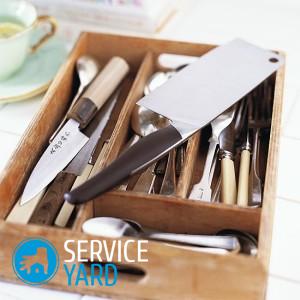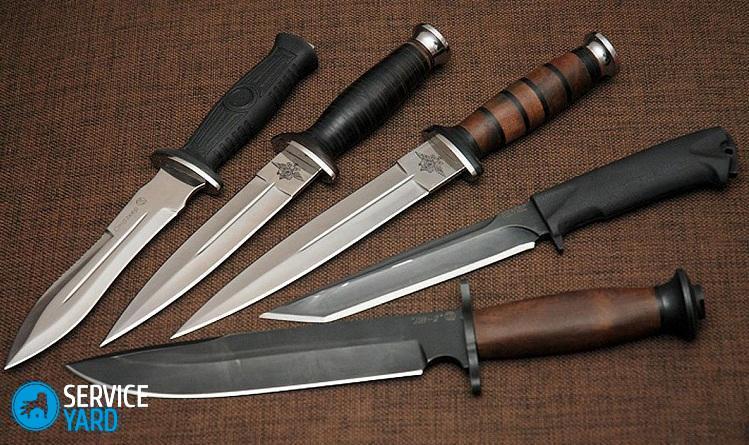How to choose a knife?

The knife is one of the first tools of man. Gradually, he developed from a silicon version to a modern knife made of very durable steel. Today, this item is used in a wide range of areas - from cooking to self-defense. To choose the right tool, you need to clearly imagine what it is for. Therefore, in this article we will try to give you recommendations on how to choose a knife.
to contents ↑Types and features of knives
I would like to immediately indicate that there are no knives “just like that”, for everything. Each of the types is necessarily strictly functional and designed to achieve certain goals. Let's take a closer look at what they are.
Sports
Throwing and training varieties fall into this category. Such knives have the following characteristics:
- Weight and balance. The more the product is balanced, the more accurately it rushes to the goal.
- They can withstand grinding quite poorly.
- They can be made of composite materials, wood, plastic and metal.
- If desired, such knives can be cut, however, it will be inconvenient and ineffective.
- Throwing knives do not have a handle, because when thrown, it can be damaged. The handle can be replaced with a rope wrapped around the blunt part of the knife.
- They do not have hardening.
Important! In special forces training, imitations of combat knives are used. As a rule, they repeat combat originals in everything, with the exception of cutting and stitching parts that can cause injury during training. Often the cost of such copies is as close as possible to the cost of the original.
Fixed blade
Similar models differ in shape, material of the handle and the length of the blades. To choose the right knife, I would like to note the following:
- The shape of the product affects the comfort of handling it, as well as the ability to carry out certain manipulations with it.
- Depth of the cut and chopping characteristics of the knife (together with the weight of the blade) will depend on the length of the blade. Short views are suitable for finer knife operations. And longer ones make it possible to cut soft and voluminous products well: cheese, bread, melon, watermelon.
- Also, the length of the cutting edge is important for the length and depth of the cut. It depends on the shape of the blade.
- The width of the blade allows you to adjust the control of the slices. The wider blade cuts product fragments remarkably in a flat line. The narrower - on the contrary, makes it possible to maneuver during cutting, easily changing the direction of movement. A similar blade will be useful if you need to beautifully cut a piece of the product.
- The thickness of the blade provides a level of strength and rigidity. The thicker the blade, the stronger the knife and the less risk that it will bend or break. But knives with thick blades hardly pass through the products, meeting little resistance. Thin blades easily glide in the thickness of products, but are less durable and can bend. Here a lot means the angle at which the edges converge to the cutting edge.
Tourist
This variety includes all knives that are used in camping conditions for harvesting firewood, extracting food, and building shelter from the weather. They can vary from universal to strictly specialized, for example, a machete.
These include fishing and hunting knives. They are distinguished by hardening quality and strength, which provide them with a sufficient degree of reliability in operation:
- Hunting - these knives are widely used on the hunt for hunting game, as well as for flaying and cutting carcasses. They can also be used in the process of organizing an overnight stay - to plan columns for a pot, pegs for a tent, cut branches for flooring in a tent or for a fire.
Important! Such knives have increased strength due to the excellent hardening of steel, so that they are slightly susceptible to breakage and dullness. For flaying, special types are used - scanners, with a short blade. They are the most practical and require a minimum of care.
- Fishing knives. They are used to edit fishing equipment, cut out a deeply swallowed hook from the mouth of fish, and dress weights.
Kitchen
They have a huge assortment for cutting a wide variety of products. For comfortable work with products in the kitchen you need only three knives:
- Small - 25-30 cm.
- Medium - 30-35 cm.
- Large - 35-40 cm.
But if you are not comfortable with such a set, then you can add others to the farm. The main thing is to understand which one you need to choose a knife:
- Serreytorny (for cutting vegetables) - has small cloves that facilitate cutting.
- For fresh bread - the same form as the previous one.
- Cheese - has a wavy cutting edge and Teflon coating, which protects against cheese sticking to the blade.
- Fillet - thanks to special grooves on the blade and special sharpness, such a knife easily mills the fish, cutting it into very thin slices.
- For pizza - with teeth and in the form of a handle with a sharpened rotating disk.
How to choose a knife for the kitchen?
To choose a quality knife for the kitchen, you need to pay attention to the following parameters:
- Material. The kitchen knife must be made of high quality hardened steel that is resistant to dulling. To do this, the knives can be coated with a layer of titanium, vanadium, molybdenum.
Important! The most expensive, but also the highest quality products are made of multilayer damask steel. Ceramic views are also not bad, but their minus is fragility upon impact - if you accidentally drop it on the floor, the blade may just fall apart.
- Sharpening method. The most optimal options are products with laser sharpening. The more you cut, the sharper your knife will be.
Important! The disadvantage of such knives is their high cost.
- Handle. It can be made of various materials - wood, plastic, metal. Metal handles are comfortable and durable, but they significantly increase the weight of the knives. Wood is exposed to moisture and temperature changes. Plastic handles are the best option, as they are light weight and are not afraid of damp.
- Width of blade blade. A wide canvas is appropriate for working with meat. Knife blades of medium size are considered universal. Narrower blades do a fine job with delicate work and slicing fruits and vegetables.
Folding knives
These types of knives are particularly comfortable to wear and use. However, the presence of numerous moving small parts makes them less reliable compared to other models.
In order to choose a good folding knife, you should pay attention to such nuances.
Blade locking mechanism
In relation to this parameter, folding knives are divided into:
- Liner lock - with this system, there is a recess in the carrier plate of the handle and part of it is bent inward. In open form, it props the blade shank. To close, it is necessary to slide the plate outward, giving the blade the opportunity to free itself.
- Lock-back - here the blade has a hook that clings to a lever equipped with a spring. During opening, this lever catches the blade, so that it is held open. When the lever is pressed, the blade folds seamlessly.
- Slip-joint - in this option there is no rigid fixation of the blade.To prevent spontaneous closure, a safety spring is provided in the system. In order to close the blade, you only need to put a little effort on the butt.
Important! To check the reliability of the latch of the folding knife, turn the knife with the blade up. Hold the index finger and thumb so that when closing the blade does not fall on them, apply a strong blow with a butt on a hard surface. A well-made retainer should not let the knife fold.
Easy blade opening
Probably, everyone remembers Soviet folding knives, which had to be opened with anything but fingers. So, a good folding knife should open thanks to the easy wave of fingers. At the same time, its blade should not dangle or move in any way.
Multifunctionality
Modern models, in particular the Swiss military, have, in addition to the main knife, many other devices in the set - scissors, a screwdriver, a hexagon. “Opener" and others.
to contents ↑Important! When buying, you should pay attention to what exactly from the proposed set is useful to you, because the prices of such knives are sometimes quite high.
Steel selection
A lot of its parameters will depend on the steel grade of the knife, starting from strength and hardness, ending with how this knife needs to be sharpened. Therefore, to choose a knife, you need to pay special attention to this parameter:
- If you do not want to constantly clean the knife, then it is better to choose a stainless steel, that is, steel with a chromium content of at least 12%. Otherwise, you will often have to deal with its processing.
- The hardness of the steel is preferably chosen within 58-60 units on the Rockwell scale (a special scale for measuring hardness). Less is not necessary, since the knife must be durable and cope with tasks of various kinds. More - also not worth it, because too much hardness leads to fragility.
to contents ↑Important! For too hard knives, the edge can crumble, and it is much more difficult to sharpen them.
Universal tips:
- When buying knives, do not give in to the calls of sellers and buy sets of knives. Especially if these sets are sold to you at a high price. You will very quickly come to the conclusion that for daily use you need only one or two knives. The rest will simply be an unnecessary burden. It is better to buy a pair of good, but really necessary products.
- You should not buy knives from “stray” sellers, on the streets, fairs or markets. Most likely you will be slipped a poor quality product, the real price of which is much lower than the seller. Try to buy such things in company stores.
- Give preference to famous brands. Although the price of products of famous companies and higher, but it will serve as a guarantee for the purchase of really good products, which can serve you for more than a dozen years.
- Be sure to learn the rules for sharpening knives, as careless or improper sharpening, you can irreparably ruin a good thing.
- Do not use knives for any extraneous purposes - cutting solid objects, loosening bolts. This can jag and warp the blade.
Stock footage
So, to choose a knife, you need to pay attention to the different characteristics of the products on sale. Approach the purchase wisely, and then you do not have to regret your choice and go for a new tool every month.
- How to choose a vacuum cleaner taking into account the characteristics of the house and coatings?
- What to look for when choosing a water delivery
- How to quickly create comfort at home - tips for housewives
- How to choose the perfect TV - useful tips
- What to look for when choosing blinds
- What should be running shoes?
- What useful things can you buy in a hardware store
- Iphone 11 pro max review
- Than iPhone is better than Android smartphones




